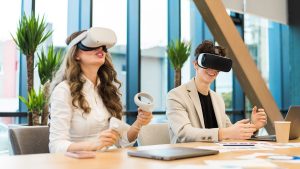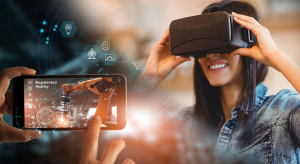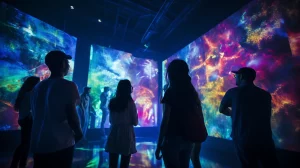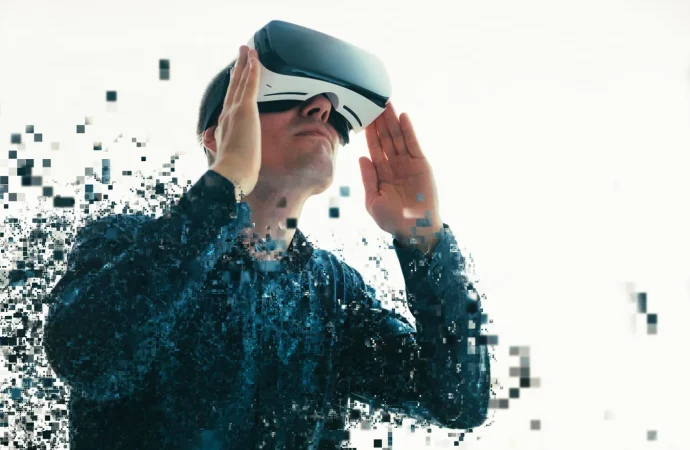Introduction Augmented Reality (AR) has emerged as a revolutionary technology that blends the physical and digital worlds, offering users immersive experiences that were once the realm of science fiction. By overlaying digital information onto the real world, AR enhances our perception of reality and opens up new possibilities across various industries, from entertainment and education
Introduction
Augmented Reality (AR) has emerged as a revolutionary technology that blends the physical and digital worlds, offering users immersive experiences that were once the realm of science fiction. By overlaying digital information onto the real world, AR enhances our perception of reality and opens up new possibilities across various industries, from entertainment and education to healthcare and retail. This article delves into the role of augmented reality in creating immersive experiences, exploring its applications, benefits, challenges, and future potential.
What is Augmented Reality?

Image by: Google.com
Augmented Reality (AR) is a technology that superimposes digital content such as images, sounds, and other sensory enhancements onto our view of the real world. Unlike Virtual Reality (VR), which creates a completely artificial environment, AR enhances the existing environment with digital elements. This fusion of the real and virtual worlds creates a more immersive experience, allowing users to interact with both physical and digital objects in real-time.
The Evolution of Augmented Reality

Image by: Google.com
The concept of AR has been around for decades, but it has only recently gained traction due to advancements in technology. Early AR systems were bulky and limited in functionality, but today’s AR devices are more sophisticated and accessible. The development of powerful smartphones, wearable devices, and advanced software has made AR more practical and widespread.
Applications of Augmented Reality

Image by: Google.com
- Entertainment and Gaming
One of the most popular applications of AR is in the entertainment and gaming industry. Games like Pokémon GO have demonstrated the potential of AR to create immersive experiences that blend the virtual and real worlds. By using AR, game developers can create interactive and engaging experiences that captivate players and keep them coming back for more.
- Education and Training
AR is also making significant strides in the field of education and training. By overlaying digital information onto the real world, AR can create interactive learning experiences that enhance understanding and retention. For example, medical students can use AR to visualize and interact with 3D models of the human body, while engineers can use AR to simulate complex machinery and systems.
- Retail and E-commerce
In the retail sector, AR is transforming the way consumers shop. By allowing customers to visualize products in their own environment before making a purchase, AR can enhance the shopping experience and reduce the likelihood of returns. For example, furniture retailers can use AR to show customers how a piece of furniture would look in their home, while fashion retailers can use AR to let customers try on clothes virtually.
- Healthcare
AR is also being used in healthcare to improve patient care and outcomes. Surgeons can use AR to visualize complex procedures and enhance their precision, while patients can use AR to better understand their medical conditions and treatment options. Additionally, AR can be used for rehabilitation and therapy, providing patients with interactive exercises and real-time feedback.
- Real Estate
In the real estate industry, AR is being used to create virtual tours of properties, allowing potential buyers to explore homes and buildings without having to visit them in person. This can save time and resources for both buyers and sellers, and provide a more immersive and engaging experience.
Benefits of Augmented Reality

Image by: Google.com
- Enhanced User Experience
One of the primary benefits of AR is its ability to create immersive and engaging user experiences. By blending the physical and digital worlds, AR can provide users with a more interactive and personalized experience, enhancing their engagement and satisfaction.
- Improved Learning and Retention
AR can also enhance learning and retention by providing interactive and visual learning experiences. By allowing users to interact with digital content in a real-world context, AR can make learning more engaging and effective.
- Increased Efficiency and Productivity
In industries such as healthcare, manufacturing, and logistics, AR can improve efficiency and productivity by providing real-time information and guidance. For example, AR can help surgeons visualize complex procedures, guide workers through assembly processes, and assist logistics personnel in locating and handling items.
- Enhanced Marketing and Sales
AR can also enhance marketing and sales efforts by providing customers with interactive and personalized experiences. By allowing customers to visualize products in their own environment, AR can increase engagement and conversion rates, and reduce the likelihood of returns.
Challenges of Augmented Reality

Image by: Google.com
- Technical Limitations
Despite its potential, AR still faces several technical challenges. These include issues related to hardware performance, software compatibility, and user interface design. Additionally, creating high-quality AR content can be time-consuming and expensive.
- Privacy and Security Concerns
AR applications often require access to sensitive data, such as location information and camera feeds, raising concerns about privacy and security. Ensuring that AR applications are secure and that user data is protected is critical to gaining user trust and widespread adoption.
- User Acceptance and Adoption
While AR has the potential to create immersive experiences, gaining user acceptance and widespread adoption can be challenging. Users may be hesitant to adopt new technologies, especially if they require significant changes to their existing habits and routines.
The Future of Augmented Reality

Image by: Google.com
The future of AR is promising, with continued advancements in technology expected to drive further innovation and adoption. As AR devices become more powerful and accessible, and as developers create more high-quality AR content, the potential for AR to create immersive experiences will continue to grow.
- Integration with Other Technologies
One of the key trends in the future of AR is its integration with other emerging technologies, such as Artificial Intelligence (AI), Internet of Things (IoT), and 5G. By combining AR with these technologies, developers can create even more immersive and interactive experiences.
- Expansion into New Industries
While AR is already making an impact in industries such as entertainment, education, and healthcare, its potential applications are far-reaching. In the future, we can expect to see AR being used in a wider range of industries, from agriculture and construction to finance and tourism.
- Improved Accessibility and Usability
As AR technology continues to evolve, it is expected to become more accessible and user-friendly. Advances in hardware and software will make AR devices more affordable and easier to use, driving greater adoption among consumers and businesses.
Conclusion
Augmented Reality is playing a pivotal role in creating immersive experiences that enhance our interaction with the world around us. From entertainment and education to healthcare and retail, AR is transforming the way we live, work, and play. While there are challenges to overcome, the potential benefits of AR are immense, and its future is bright. As technology continues to advance, AR will undoubtedly continue to shape and enrich our experiences in ways we can only begin to imagine.
















